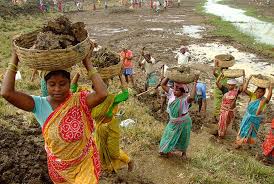 By Biswaraj Patnaik in Puri, February 3, 2022: A national budget of a country with vision is a critical component of good governance. Governments get money from taxes and fees, and spend it on defence, infrastructure, research grants, education, promotion of arts culture, and social development programs such as social security and healthcare.
By Biswaraj Patnaik in Puri, February 3, 2022: A national budget of a country with vision is a critical component of good governance. Governments get money from taxes and fees, and spend it on defence, infrastructure, research grants, education, promotion of arts culture, and social development programs such as social security and healthcare.
The government budget is prepared by the government officials including ministers invariably guided by bureaucrats and domain professionals taken on board. The budget document anticipates tax revenues from inheritance tax, income tax, corporation tax, import taxes etc and proposed spending mainly on healthcare, education, defence, roads, poverty alleviation efforts, employment generation, public goods and infrastructure, justice delivery and public order and more across the coming financial year.
All federal budgets comprise three primary components: revenues, discretionary spending, and direct spending. Total expenditure in FY23 seen at INR 39.45 tn, Total receipts in FY23 seen at INR 22.84 tn. Capital expenditure expected to be INR 7.5tn in FY23 up from INR 6.03tn in FY22 revised estimates, Fiscal deficit for FY22 is revised to 6.9% from 6.8% as per the earlier budgeted estimates (BE), FY23 BE of fiscal deficit is pegged at 6.4%. A new provision will allow the income taxpayers to file an updated return within 2 years from the end of the relevant assessment year.
 Alternate minimum tax will be reduced to 15% for cooperative societies and custom duty exemption on steel scrap is being extended by a year to help the MSME sector . Tax deduction limit has been increased to 14% on employers’ contribution to NPS account of state government employees.
Alternate minimum tax will be reduced to 15% for cooperative societies and custom duty exemption on steel scrap is being extended by a year to help the MSME sector . Tax deduction limit has been increased to 14% on employers’ contribution to NPS account of state government employees.
The budget’s vision becomes even more important during a global pandemic that has contracted the world economy by 3.1% in 2020, when shockingly India’s economy contracted by a whopping 7.3%, the worst among major economies of the world. It could be worse as the disastrous effects on the unorganised sector have not been assessed at all, which accounts for roughly 30% of the GDP, 40% of exports, and a mind boggling 90% of employment.
The only serious intervention the finance minister Nirmala Sitharaman has made for job increase is in the capital investment sector. The age old 1.3% of the GDP is intended to be increased to 2.9%.This is of course critical for several reasons:•
• Most public investment in India is undertaken by state governments and much less by the Union government. The states cannot increase public investment as they have managed the second wave of COVID 19 on their own. They have of course strict commitments on borrowing on account of the Fiscal Responsibility and Budget Management (FRBM) Act.
• An increase in public investment is required to crowd in private investment, a typical Keynesian measure. This is rather contrary to the Union government’s policy stance for the last two years, when the size of the fiscal stimulus was barely 2.1% and 1.9% of the GDP. This is very stingy compared with the emerging market economies in 2020 alone stimulating respective economies by 4.7% of GDP.Bad budget news just too many:
• First, the finance minister implicitly recognised the problem of joblessness when she said the Union government plans to create six million jobs over the next five years. Recognising a problem doesn’t not necessarily mean she has understood the scale of the problem which has three dimensions :
• Nearly five million young educated people have joined the labour force looking for livelihood.
• There were 30 million unemployed in 2019. 10 million have been added to that number during the corona pandemic.
• And 32 million semi and unskilled migrant labourers have returned to agriculture between 2019 and 2020, without receiving the least succour.
The reverse migrants have come hoping the much-hyped Mahatma Gandhi National Rural Employment Guarantee Act would sustain them. Though the programme is a life-saver at a time of desperation, overcrowding of job seekers al on a sudden has caused loss of wits among governments without good enough funds.
Most migrant labour source states specifically the Hindi belt, West Bengal, Odisha and Assam have hardly any livelihood opportunity available to accommodate so many distressed people. These states now have to support 32 million returnees.
The Union government had allocated Rs 60,000 crore in FY21, and then increased it to Rs 1.1 lakh crore but still, there were arrears left to be paid to states in FY22. In FY22, it allocated Rs 70,000, to which another Rs 15,000 crore was added, but has not sufficed. Millions of workers were denied work.
 More hurtingly, though the notified MGNREGA wage rates increased by 4% between FY 2020-21 and FY 2021-22, the actual wages paid remained lower than the notified wage rates till December 31, 2021.
More hurtingly, though the notified MGNREGA wage rates increased by 4% between FY 2020-21 and FY 2021-22, the actual wages paid remained lower than the notified wage rates till December 31, 2021.
The finance minister says they are sensitively aware of the grim situation. But merely recognising a problem is not understanding the scale of the problem, which has three dimensions.
About five million young educated people join the labour force looking for work each year. There were already 30 million unemployed by 2019. Another 10 million have been added to that number in the wake of COVID-19.
And 32 million semi- and unskilled migrant labourers that chose to be back in the fields between 2019 and 2020 have hardly received any succour. One only witnesses a reversal of the trend.The number of workers in agriculture between 2004-05 and 2019 have diminished alarmingly.
These reverse migrants have come rushing back believing the Mahatma Gandhi National Rural Employment Guarantee Act (MG-NREGA) can save them in their villages. The programme has been kind of a life-saver at horrifically distressed times, but not good enough to sustain them across a year. Livelihood opportunities have gone badly missing in the migrant labour source states particularly the Hindi belt, West Bengal, Odisha and Assam. An over-crowded labour situation in these states is now struggling in vain to support at least 32 million returnees.
The Union government had allocated Rs 60,000 crore in FY21, then increased it to Rs 1.1 lakh crore; but never disbursed the dough. There are huge arrears to be paid to states. For FY22, it had allocated Rs 70,000, to which another Rs 15,000 crore was added. Yet the amount has not sufficed at all. Millions of workers were denied work and are languishing in penury.
Even more sadly, the notified MGNREGA wage rates were increased by 4% between FY 2020-21 and FY 2021-22, but actual wages that were paid remained far lower than the notified rates for most states till December 31, 2021. The difference between employment demanded and employment provided, was highest in April and September 2021 at 33% and 31%, respectively. For FY 2021-22 until December 31, 2021, around 91 lakh households that demanded work never received it.
The Modi government’s framework is rather dismal because it’s essentially to please corporates that fund the ruling political party.
 Odisha chief minister Naveen Patnaik has dispassionately hailed a very few of the good budget components. And rightly has he slammed the many anti-poor, anti-middle class plans of spending public money.
Odisha chief minister Naveen Patnaik has dispassionately hailed a very few of the good budget components. And rightly has he slammed the many anti-poor, anti-middle class plans of spending public money.
Making diamonds, frozen mussels, frozen squids, asafoetida, cocoa beans, methyl alcohol and acetic acid cheaper and imported umbrellas costlier has not gone well with the middle class. Strangely, daily use items like headphones, audio systems, smart meters, imitation jewellery, solar cells and solar modules will be more expensive, when renewable energy is a focused sector to promote green energy.
Meanwhile, BJP’s close associate and funder Gautam Adani has dethroned Mukesh Ambani to be crowned the richest Indian.


Leave a Reply
Be the First to Comment!